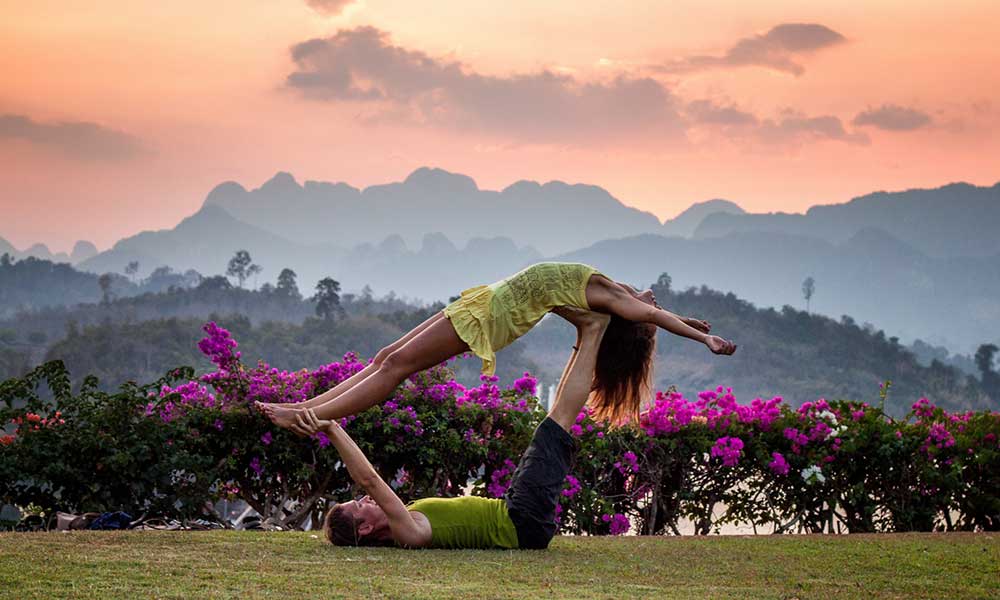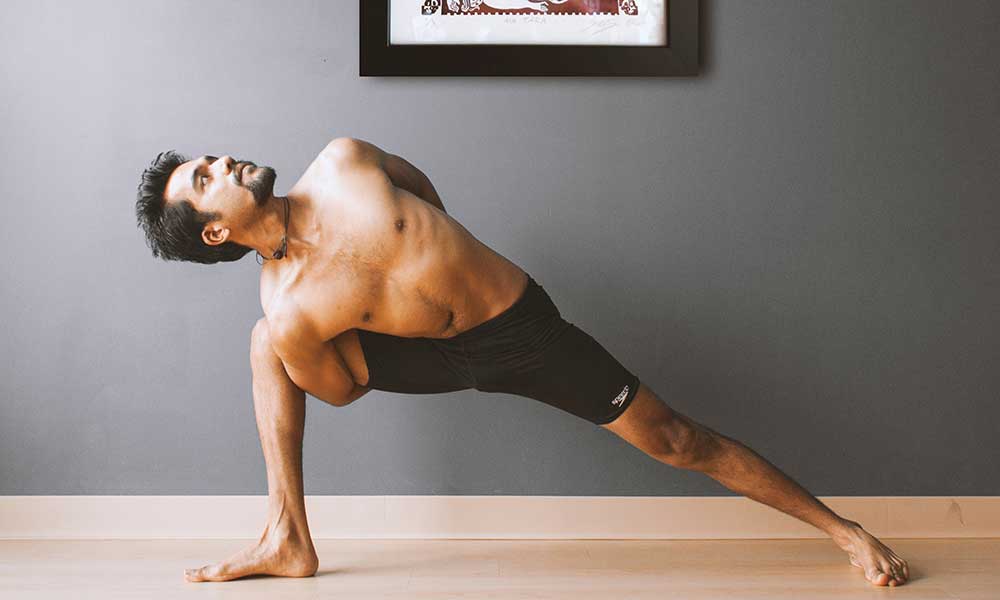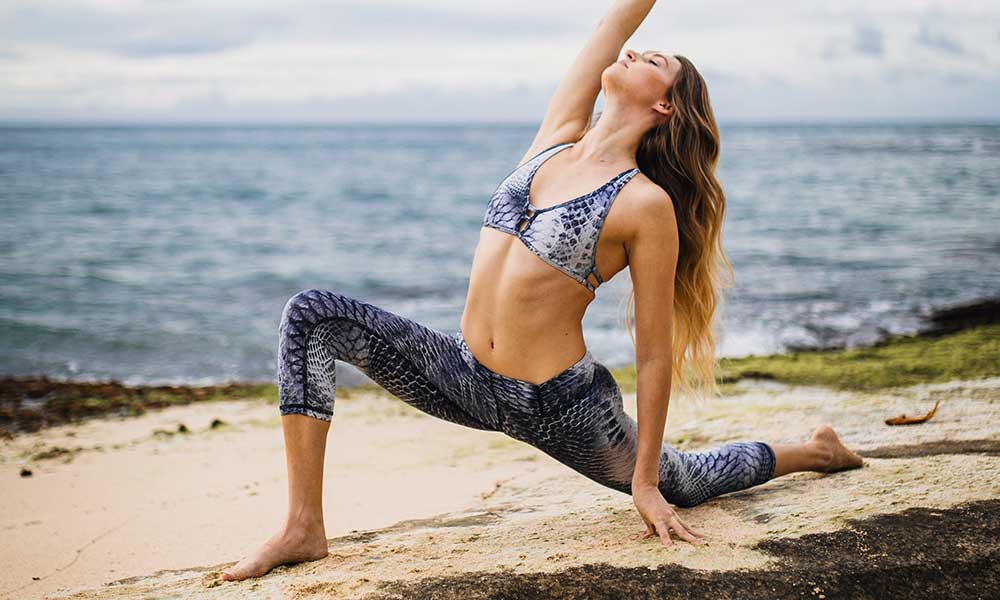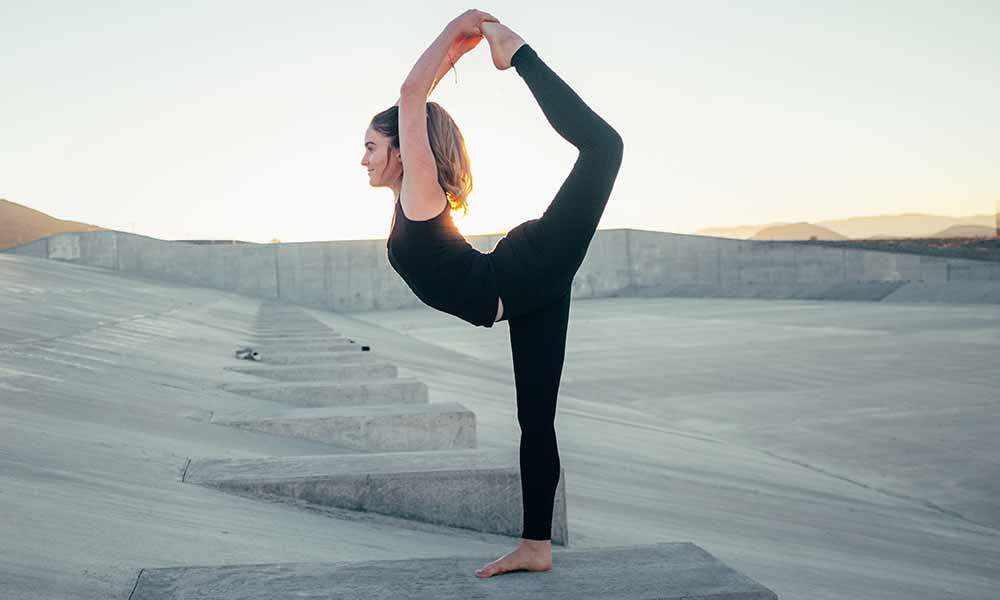Yoga is an ancient and popular practice that takes many forms.
If you have been in the yoga game long enough, you may have seen a pair of yogis practicing a dynamic balancing act before or after class, at the beach, or in a park! Acro Yoga is a form of yoga that is practiced in pairs.
This nifty practice combines the best of acrobatics, yoga, and Thai massage.
If you have ever been curious about trying it or felt like it was above your skill level, this article is for you!
Here is the scoop on Acro Yoga.
What Is Acro Yoga?
Acro Yoga is a style of partner yoga, where two participants practice together on the mat for two main reasons: therapeutic release and acrobatic fun.
This form of yoga began in San Francisco in 2003 when Jason Nemer and Jenny Sauer-Klein began integrating their yoga practice together.
After getting into a rhythmic flow with one another, the pair decided to combine their backgrounds in yoga and circus arts to develop partnered versions of traditional yoga postures to build community and promote the importance of partnership.
Acro Yoga is a lovely combination of yoga, acrobatics, and Thai massage.
While yoga philosophy invites us to be aware of the breath and connected to our bodies, acrobatic practices cultivate trust, empowerment and joy by supporting your partner in a powerful, playful way.
The element of Thai massage in Acro Yoga adds a layer of healing, peace, and love.
How Does Acro Yoga Work?
In Acro Yoga, one of the partners serves as the base and the other is the flyer.
The base’s role is to support the flyer in a sequence of aerial postures.
In a typical Acro Yoga class, a spotter will be present to check that everyone has good alignment and to prevent the flyers from falling.
Usually, the base will lie on his or her back with legs extended to support the flyer’s weight.
A common misconception about Acro Yoga is that the smaller partner must always be the flyer, however this is not always the case.
Our legs are capable of supporting a lot of weight if they are positioned correctly, with ankles extended directly over the hips.
The base can use their feet to support the hips of the flyer for backbends or their shoulders for inversion postures.
There are so many fun combinations in Acro Yoga, and yogis of all shapes and sizes can partake.
The Difference Between Acro Yoga And Yoga
What you put into a practice is what you get out.
Acro Yoga is yoga, but with an added challenge.
When you add another human’s weight to your own, there are going to be some major differences.
Here are some of the biggest distinctions:
- Acro Yoga helps you develop your flexibility more than traditional yoga: Doing these postures with the addition of another person’s mass gives you an active loaded stretch, opening up your hips, hamstrings, lower back, and ankles much deeper than if you were doing them on your own.
- Acro Yoga helps you build a deeper sense of trust in yourself and others: Traditional yoga teaches you to trust yourself, but Acro Yoga teaches you to extend this trust to another human being. During your personal yoga journey, there were probably many times where you had to trust your own strength and sense of awareness before attempting an arm balance or certain standing poses. In Acro Yoga, you must learn to give up some level of control while surrendering to the strength and balance of your partner. This can be scary, but it can help us reach a level of peace and safety that is hard to find elsewhere.
- Acro Yoga is more playful than traditional yoga: It’s easy to take ourselves too seriously from time to time during our yoga practice. In Acro Yoga, you will quickly find that laughter is a key part of the practice. The binding of two energies in a co-creative activity brings about a natural playfulness that is fun, energizing and loving. There might be moments that are awkward and funny, but these are the moments that foster a deep sense of connection with another yogi soul.
Tips On How To Get The Most Out Of Acro Yoga
Acro Yoga is a practice that can deepen your understanding and admiration of yoga and cultivate feelings of passion and gratitude for ourselves and our community.
If you’re curiosity is piqued and you are thinking about taking a class, read the following tips on how you can get the most from your Acro Yoga practice:
- No partner? No problem! Don’t worry if you don’t already have a partner to take the class with. Even if you show up solo to class, you will surely have a partner to work with once you get there. Yogis are more than welcome to arrive with a dedicated partner, but there is a wealth of knowledge and wisdom to be gained from practicing with a new partner from time to time.
- Acro Yoga is for everybody: The beauty of Acro Yoga is that you don’t have to be a gymnast, circus acrobat or skilled yogi to benefit from this lovely practice. Not all Acro Yoga postures are advanced. The purpose of Acro Yoga is to build trust and embrace the beauty of divine partnership. Through practice, you will build the skills you need to reach new heights.
- Size doesn’t matter: Anyone can be a base and anyone can be a flyer, regardless of size. Acro Yoga honors technique more than physical strength. If you are being mindful with your technique, you will be surprised how far you can go.
- Communicate your needs: When we practice alone, we only have to deal with ourselves within the constraints of our own minds. Since this practice is deeply rooted in partnership, you will need to share the experience with your partner by using clear, open, and direct verbal communication. Trying to give another person directions while doing paired yoga postures can get tricky, which means you will need to work as a team. This can help us to become patient, compassionate communicators.
Frequently Asked Questions
Here are some of the most common questions people have about Acro Yoga.
How is Acro Yoga different from Yoga?
Acro Yoga is, in fact, yoga.
However, Acro Yoga is a partner style of yoga that encourages levity and focuses on the importance of divine partnerships.
Acro Yoga is a combination of yoga, acrobatics, and thai massage.
What are the benefits of AcroYoga?
Just like with other styles of yoga, Acro Yoga has a wide range of benefits.
Physically, Acro Yoga deepens your flexibility practice, and builds strength.
On an emotional level, it helps participants to develop trust, communication skills, and relieve stress.
Is Acro Yoga hard?
Acro Yoga invites us to add the playful challenge of balancing and supporting another human’s body weight with our own.
While there are challenging moments, yogis of all skill level can benefit from Acro Yoga.
How do I start Acro Yoga?
To take an Acro Yoga class, start by researching yoga studios in your area that offer a class.
You might even be able to find classes online. If you don’t have a partner, don’t worry!
Show up to class anyway and partner up with someone new.







